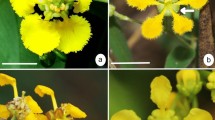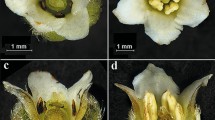Abstract
The reproductive biology ofW. berteroi, W. fernandeziana, and a putative hybrid betweenW. fernandeziana andW. grahamiae, endemic to Robinson Crusoe Island (Juan Fernández archipelago, Chile) was studied. Flowers are hermaphroditic, protandrous, offer nectar, and exhibit secondary pollen presentation involving pollen collecting hairs on the style. These features imply allogamy and biotic pollination. However, male and female phases overlap and no effective pollinators were observed. Experimental data indicate these taxa are self-compatible and facultatively autogamous, a conclusion also suggested by the pollen/ovule ratios. Selfing is accomplished when the stigmatic lobes reflex and touch the style, except forW. berteroi where they do not reflex completely. Autogamy is accomplished in the latter when pollen grains deposited on the inner surface of the corolla throat by the “pollen brush” are gathered by stigmatic lobes when shaken by wind. The degree of autogamy, and perhaps self-compatibility, seems to be inconstant, as implied by the variable natural seed set (overall range 21–188 seeds per fruit). A mixed mating system — primarily outcrossing/entomophilous, but also autogamous — must have been present in the continental ancestors of these taxa. Autogamy promoting self-fertilization is important now — on an island with scarce pollinators — and in the past — when the first founders arrived.
Similar content being viewed by others
References
Anderson G. J. (1995) Systematics and reproductive biology. In: Hoch P. C., Stephenson A. G. (eds.) Experimental and molecular approaches to plant biosystematics, Monogr. Syst. Bot. 53, pp. 263–272. Missouri Botanical Garden, St. Louis.
Anderson G. J., Bernardello G., Lopez S. P., Stuessy T. F., Crawford D. J. (2000) Dioecy and wind pollination inPernettya rigida (Ericaceae) of the Juan Fernández Islands. Bot. J. Linn. Soc. (in press).
Anderson G. J., Symon D. E. (1989) Functional dioecy and andromonoecy inSolanum. Evolution 43: 204–219.
Baker H. G., Baker I. (1983) Floral nectar sugar constituents in relation to pollinator type. In: Jones C. E., Little R. J. (eds.) Handbook of experimental pollination biology. Van Nostrand Reinhold, New York, pp. 117–141.
Bernardello G., Anderson G. J., Lopez S. P., Cleland M. A., Stuessy T. F., Crawford D. J. (1999) Reproductive biology ofLactoris fernandeziana (Lactoridaceae). Amer. J. Bot. 86: 829–840.
Bernardello G., Galetto L., Anderson G. J. (2000) Floral nectary structure and nectar chemical composition of some species from Robinson Crusoe Island (Chile). Canad. J. Bot. (in press).
Carolin R. C. (1960) The structures involved in the presentation of pollen to visiting insects in the order Campanales. Proc. Linn. Soc. NSW 85: 197–207.
Colwell R. K. (1989) Hummingbirds of the Juan Fernández Islands: natural history, evolution and population status. Ibis 131: 548–566.
Crawford D. J., Sang T., Stuessy T. F., Kim S-C., Silva O. M. (1998)Dendroseris (Asteraceae: Lactuceae) andRobinsonia (Asteraceae: Senecioneae) on the Juan Fernandez Islands: similarities and differences in biology and phylogeny. In: Stuessy T. F., Ono M. (eds.) Evolution and speciation of island plants. Cambridge University Press, Cambridge, pp. 97–119.
Crawford D. J., Stuessy T. F., Lammers T. G., Silva O. M., Pacheco P. (1990) Allozyme variation and evolutionary relationships among three species ofWahlenbergia (Campanulaceae) in the Juan Fernandez Islands. Bot. Gaz. 151: 119–124.
Cruden R. W. (1977) Pollen ovule ratios: a conservative indicator of breeding systems in flowering plants. Evolution 31: 32–46.
Engel M. S. (2000) A newLassioglossum from the Juan Fernández Islands (Hymenoptera: Halictidae). Revista Chilena Entomol. (in press).
Erbar C., Leins P. (1989) On the early floral development and the mechanisms of secondary pollen presentation inCampanula, Jasione andLobelia. Bot. Jahr. Syst. 111: 29–55.
Erbar C., Leins P. (1995) Portioned pollen release and the syndromes of secondary pollen presentation in the Campanulales—Asterales-complex. Flora 190: 323–338.
Fahn A. (1979) Secretory tissues in plants. Academic Press, London.
Gadella T. W. J. (1964) Some cytological observations in the genusCampanula. II. Proc. Royal Netherl. Acad. Sci. Ser. C 66: 270–283.
Hauser E. J. P., Morrison J. P. (1964) The cytochemical reduction of nitro blue tetrazolium as an index of pollen viability. Amer. J. Bot. 51: 748–752.
Haviland E. (1884) Occasional notes on plants indigenous in the immediate neighborhood of Sydney. Proc. Linn. Soc. NSW 9: 1171–1174.
Holsinger K. (1991) Conservation of genetic diversity in rare and endangered plants. In: Dudley E. C. (ed.) The unity of evolutionary biology: the proceedings of the fourth International Congress of systematic and evolutionary biology. Dioscorides Press, Portland, pp. 626–633.
Holsinger K. (1992) Ecological models of plant mating systems and the evolutionary stability of mixed mating systems. In: Wyatt R. (ed.) Ecology and evolution of plant reproduction. Chapman and Hall, London New York, pp. 169–191.
Horowitz A., Harding J. (1972) Genetics ofLupinus. V. Intraspecific variability for reproductive traits inLupinus nanus. Bot. Gaz. 133: 155–165.
Inoue K., Maki M., Masuda M. (1996) Evolution ofCampanula flowers in relation to insect pollinators on islands. In: Lloyd D. G., Barrett S. C. H. (eds.) Floral biology: studies on floral evolution in animal-pollinated plants. Chapman and Hall, New York, pp. 377–400.
Knuth P. (1909) Handbook of flower pollination, 3. University Press, Oxford.
Lammers T. G. (1996) Phylogeny, biogeography, and systematics of theWahlenbergia fernandeziana complex (Campanulaceae: Campanuloideae). Syst. Bot. 21: 397–415.
Leins P., Erbar C. (1990) On the mechanisms of secondary pollen presentation in the Campanulales—Asterales-complex. Bot. Acta 103: 87–92.
Lloyd D. G. (1965) Evolution of self-compatibility and racial differentiation inLeavenworthia (Cruciferae). Contr. Gray Herb. Harvard Univ. 195: 1–134.
Lloyd D. G., Yates J. M. A. (1982) Intrasexual selection and the segregation of pollen and stigmas in hermaphrodite plants, exemplified byWahlenbergia albomarginata (Campanulaceae). Evolution 36: 903–913.
Lothian N. (1947) Critical notes on the genusWahlenbergia Schrader, with descriptions of new species in the Australian region. Proc. Linn. Soc. NSW 71: 201–235.
Marticorena C., Stuessy T. F., Baeza C. M. (1998) Catalogue of the vascular flora of the Robinson Crusoe or Juan Fernández Islands, Chile. Gayana Bot. 55: 187–211.
Martin F. W. (1959) Staining and observing pollen tubes in the style by means of fluorescence. Stain Technol. 34: 125–128.
Moeliono B., Tuyn P. (1960) Campanulaceae. In: Steenis C. G. G. J. Van (ed.) Flora Malesiana, Djakarta. 6: 107–141.
Müller H. (1883) The fertilization of flowers. (Translated by Thompson, D'A. W.). Macmillan and Co, London.
Nakamura M. (1935) On the irregular meiosis of the pollen mother cells ofI. balsamina Linn. by the effect of artificial high temperature. Japan. J. Bot. 11: 118–123.
Nyman Y. (1991) Crossing experiments within theCampanula dichotoma group (Campanulaceae). Plant Syst. Evol. 177: 185–192.
Nyman Y. (1992) Pollination mechanisms in sixCampanula species (Campanulaceae). Plant Syst. Evol. 181: 97–108.
Nyman Y. (1993a) The pollen-collecting hairs ofCampanula (Campanulaceae). I. Morphological variation and the retractive mechanism. Amer. J. Bot. 80: 1427–1436.
Nyman Y. (1993b) The pollen-collecting hairs ofCampanula (Campanulaceae). II. Function and adaptive significance in relation to pollination. Amer. J. Bot. 80: 1437–1443.
Petterson J. A. (1997) Revision of the genusWahlenbergia (Campanulaceae) in New Zealand. N. Zeal. J. Bot. 35: 9–54.
Ricci M., Eaton L. (1994) The rescue ofWahlenbergia larrainii in Robinson Crusoe Island, Chile. Biol. Conserv. 68: 89–93.
Richards A. J. (1997) Plant breeding systems. 2nd edn. Chapman and Hall, London.
Richardson T. E., Stephenson A. G. (1989) Pollen removal and pollen deposition affect the duration of the staminate and pistillate phases inCampanula rapunculoides. Amer. J. Bot. 76: 532–538.
Rosatti T. J. (1986) Sphenocleaceae and Campanulaceae. J. Arnold Arbor. 67: 38–45.
Sanders R. W., Stuessy T. F., Rodríguez R. (1983) Chromosome numbers from the flora of the Juan Fernandez Islands. Amer. J. Bot. 70: 799–810.
Schaal B. A., Leverich W. J. (1980) Pollination and banner markings inLupinus texensis (Leguminosae). Southw. Nat. 25: 280–282.
Shetler S. G. (1962) Notes on the life history ofCampanula americana, the tall bellflower. Mich. Bot. 1: 9–14.
Shetler S. G. (1979) Pollen-collecting hairs ofCampanula (Campanulaceae), I: Historical review. Taxon 28: 205–215.
Shetler S. G. (1982) Variation and evolution of the Nearctic harebells (Campanula subsect.Heterophylla). J. Cramer, Vaduz.
Skottsberg C. (1928) Pollinationsbiologie und Samenverbreitung auf den Juan Fernandez Inseln. In: Skottsberg C. (ed.) The natural history of the Juan Fernandez and Easter Islands, 2, Botany, Almqvist & Wiskell, Uppsala, pp. 503–547.
Smith P. J. (1992) A revision of the genusWahlenbergia (Campanulaceae) in Australia. Telopea 5: 91–175.
Spooner D. M., Stuessy T. F., Crawford D. J., Silva O. M. (1987) Chromosome numbers from the flora of the Juan Fernandez Islands. II. Rhodora 89: 351–356.
Stuessy T. F., Crawford D. J., Marticorena C. (1990) Patterns of phylogeny in the endemic vascular flora of the Juan Fernandez Islands, Chile. Syst. Bot. 15: 338–346.
Stuessy T. F., Marticorena C., Rodriguez R., Crawford D. J., Silva O. M. (1992) Endemism in the vascular flora of the Juan Fernandez Islands. Aliso 13: 297–307.
Stuessy T. F., Sanders R. W., Silva M. (1984) Phytogeography and evolution of the flora of the Juan Fernandez Islands: a progress report. In: Radovsky F. J., Raven P. H., Sohmer S. H. (eds.) Biogeography of the tropical Pacific. Assoc. Syst. Coll. and B.P. Bishop Museum, Lawrence, Kansas, pp. 55–69.
Stuessy T. F., Swenson U., Crawford D. J., Anderson G., Silva O. M. (1998) Plant conservation in the Juan Fernandez Archipelago, Chile. Aliso 16: 89–101.
Sun B. Y., Huessy T. D., Crawford D. J. (1990) Chromosome counts from the flora of the Juan Fernandez Islands, Chile. III. Pacific Science 44: 258–264.
Thomson G. M. (1880) On the fertilization, etc., of New Zealand flowering plants. Trans. N. Zeal. Inst. 13: 241–291.
Thulin M. (1975) The genusWahlenbergia s. lat. (Campanulaceae) in tropical Africa and Madagascar. Symb. Botanicae Upsal. 21: 1–223.
Uphof J. C. (1962) Plant hairs. In: Zimmerman W., Ozenda P. G. (eds.) Encyclopedia of Plant Anatomy, 2nd edn., 4. Borntraeger, Berlin, pp. 1–206.
Wyatt R. (1984) The evolution of self-pollination in granite outcrop species ofArenaria (Caryophyllaceae). I. Morphological correlates. Evolution 38: 804–816.
Yeo P. F. (1993) Secondary pollen presentation. Plant Syst. Evol., Suppl. 6. Springer, New York, pp. 1–268.
Zink R. A., Wheelwright N. T. (1997) Facultative self-pollination in island irises. Amer. Midl. Nat. 137: 72–78.
Author information
Authors and Affiliations
Rights and permissions
About this article
Cite this article
Anderson, G.J., Bernardello, G., Lopez, P. et al. Reproductive biology ofWahlenbergia (Campanulaceae) endemic to Robinson Crusoe Island (Chile). Pl Syst Evol 223, 109–123 (2000). https://doi.org/10.1007/BF00985330
Received:
Accepted:
Issue Date:
DOI: https://doi.org/10.1007/BF00985330




